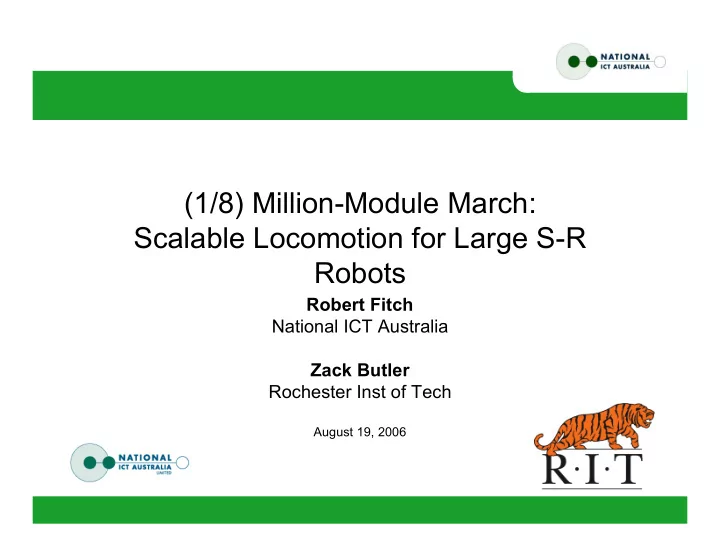

(1/8) Million-Module March: Scalable Locomotion for Large S-R Robots Robert Fitch National ICT Australia Zack Butler Rochester Inst of Tech August 19, 2006
Scalability Challenges in S-R • Useful systems will probably need thousands of modules • Each module may need to be simple • Can’t use linear space per module or linear time per action – Essentially precludes exact shapes? – Locomotion algos can use minimal space, but are restricted in operation
One Million (Point) Modules
Proposed Approach • Simplified shapes for planning • Parallel path planning via MDP-inspired dynamic programming • Safe parallel actuation via local connectivity checks • Efficiency depends on shape – This may be true for many techniques
Example: Large (22^3) Robot Among Obstacles
Sublinear Planning • Sublinear in time and space • Bounding box to describe goal – Could be arbitrarily more complex • Each module not in goal finds a path to closest goal location – Formulated as MDP – Plans are continuously updated as each module moves – Assuming SlidingCube abstraction, although not limited to this
MDP Formulation – GridWorld Example
MDP Formulation • States S: all module locations (current & potential) • Actions A: module motions (6 faces x 4 moves + null = 25) • Reward r = -1 (not in goal), or -k*height (in goal) • Policy is therefore a legal motion for each location such that each module finds a goal in minimum time • No attempt to assign goals to modules – Not all goal locations reachable anyway
MDP Implementation • Each module keeps track of adjacent locations • Assume bounding box overlaps robot • Best policies are propagated from goal • Module motions trigger updates
MDP Implementation • Bounding box can overlap any obstacle – Even insufficient size is OK – Moving bounding box produces locomotion
Parallel Actuation • Must prevent global disconnection – Check for articulation points – Heuristic search ensures all ? neighbors remain connected after motion (find connecting cycle ) – Iterative deepening limits search time • Must avoid collisions – Lock modules in connecting cycle – Test-and-set destination position – Move – Free locked modules
Parallel Actuation • Modules search locally & move in parallel
Efficiency Issues • Technique works best for blobby shapes – Modules multiply connected, many can move at once, bounding boxes for goals • But gracefully degrades as well – Dynamic program runs in O(d) time • d = diameter, can be up to n – Neighbor connectivity search also will find shortest paths but as long as required
Philosophical Points • Algorithms (for the same task) have different requirements/capabilities • Important to consider task requirements – Shape fidelity, shape geometry, heterogeneity, speed of reconfiguration • As well as (traditional) module issues – Memory, relative speed of communication and actuation, etc.
End
Example: Single Obstacle
Example: 1000 Modules with Obstacles
Recommend
More recommend